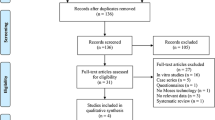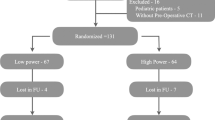Abstract
The aim of the study was to compare standard high-power laser (with < 80 Hz) to extended frequency (> 100 Hz) lithotripsy during miniPCNL. 40 patients were randomized in to two groups undergoing MiniPCNL. For both groups, the Holmium Pulse laser Moses 2.0 (Lumenis) was used. For group A, standard high-power laser with < 80 Hz, with Moses distance was set using up to 3 J. For Group B, extended frequency (100–120 Hz) was used allowing up to 0.6 J. All patients underwent MiniPCNL using an 18 Fr balloon access. Demographics were comparable between groups. Mean stone diameter was 19 mm (14–23) with no differences between groups (p = 0.14). Mean operative time was 91 and 87 min for group A and B (p = 0.71), mean laser time was similar in both groups, 6.5 min and 7.5 min, respectively (p = 0.52) as well as the number of laser activations during the surgery (p = 0.43). Mean Watts used was 18 and 16 respectively being similar in both groups (p = 0.54) as well as the total KJoules (p = 0.29). Endoscopic vision was good in all surgeries. The endoscopic and radiologic stone free rate was achieved in all patients expect for two in both groups (p = 0.72). Two Clavien I complications were seen, a small bleeding for group A and a small pelvic perforation in group B. The use of high-power holmium laser with extended frequency and optimized Moses was effective and safe being comparable to standard high-power laser for MiniPCNL allowing more versatility with the setting range.
Similar content being viewed by others
Data availability
The data that support the findings of this study are available from the corresponding author, EE, upon reasonable request.
References
De Sio M, Manfredi C, Fusco F, Creta M, Mirone V, Arcaniolo D (2021) Recent advances in percutaneous lithotripsy techniques. Curr Opin Urol 31(1):24–28. https://doi.org/10.1097/MOU.0000000000000829. (PMID: 33196538)
Wright HC, Sherman Z, Monga M, De S (2020) The role of laser in percutaneous surgery. Is this the best option for this approach? Arch Esp Urol 73(8):753–766
Bujons A, Millán F, Centeno C, Emiliani E, Sánchez Martín F, Angerri O, Caffaratti J, Villavicencio H (2016) Mini-percutaneous nephrolithotomy with high-power holmium YAG laser in pediatric patients with staghorn and complex calculi. J Pediatr Urol 12(4):253.e1–5. https://doi.org/10.1016/j.jpurol.2016.04.027. (Epub 2016 May 26 PMID: 27264051)
Rice P, Somani BK (2022) Percutaneous laser nephrolithotripsy: is it here to stay? Results of a systematic review. Curr Opin Urol 32(2):185–191
Manzo BO, Torres JE, Cabrera JD, Lozada E, Emiliani E, Sepulveda F, Morales C, Morales I, Sanchez HM (2021) Simplified biplanar (0–90°) fluoroscopic puncture technique for percutaneous nephrolithotomy: the learning curve. World J Urol 39(9):3657–3663
Thomas K, Smith NC, Hegarty N, Glass JM (2011) The Guy’s stone score–grading the complexity of percutaneous nephrolithotomy procedures. Urology 78(2):277–281
Zhu W, Liu Y, Liu L, Lei M, Yuan J, Wan SP, Zeng G (2015) Minimally invasive versus standard percutaneous nephrolithotomy: a meta-analysis. Urolithiasis 43(6):563–570
Ruhayel Y, Tepeler A, Dabestani S, MacLennan S, Petřík A, Sarica K, Seitz C, Skolarikos A, Straub M, Türk C, Yuan Y, Knoll T (2017) Tract sizes in miniaturized percutaneous nephrolithotomy: a Systematic Review from the European Association of Urology Urolithiasis Guidelines Panel. Eur Urol 72(2):220–235
Pauchard F, Ventimiglia E, Corrales M, Traxer O (2022) A Practical Guide for Intra-Renal Temperature and Pressure Management during Rirs: What Is the Evidence Telling Us. J Clin Med 11(12):3429
Doizi S, Uzan A, Keller EX, De Coninck V, Kamkoum H, Barghouthy Y, Ventimiglia E, Traxer O (2021) Comparison of intrapelvic pressures during flexible ureteroscopy, mini-percutaneous nephrolithotomy, standard percutaneous nephrolithotomy, and endoscopic combined intrarenal surgery in a kidney model. World J Urol 39(7):2709–2717
Haddad M, Emiliani E, Rouchausse Y, Coste F, Doizi S, Berthe L, Butticé S, Somani B, Traxer O (2017) Impact of the Curve Diameter and Laser Settings on Laser Fiber Fracture. J Endourol 31(9):918–921
Author information
Authors and Affiliations
Contributions
Protocol/project development: EE, AKK, and OA. Data collection or management JB, SF, JA, JC-C, and AS-P1. Data analysis: JI-P2. Manuscript writing/editing: EE, AKK, OA. FS-M1, and FM1.
Corresponding author
Ethics declarations
Conflict of interest
The authors declare no conflict of interests.
Additional information
Publisher's Note
Springer Nature remains neutral with regard to jurisdictional claims in published maps and institutional affiliations.
Rights and permissions
Springer Nature or its licensor (e.g. a society or other partner) holds exclusive rights to this article under a publishing agreement with the author(s) or other rightsholder(s); author self-archiving of the accepted manuscript version of this article is solely governed by the terms of such publishing agreement and applicable law.
About this article
Cite this article
Emiliani, E., Kanashiro, A.K., Balaña, J. et al. Use of Moses 2.0 with extended frequency and optimized Moses vs. high-power laser in MiniPCNL: a randomized controlled trial. Urolithiasis 51, 75 (2023). https://doi.org/10.1007/s00240-023-01443-5
Received:
Accepted:
Published:
DOI: https://doi.org/10.1007/s00240-023-01443-5




